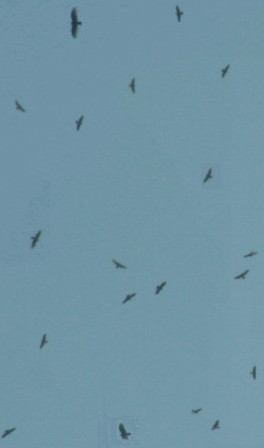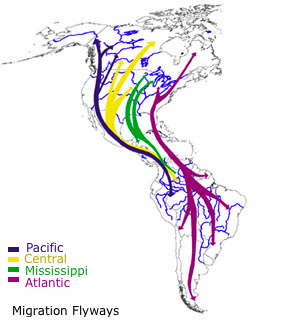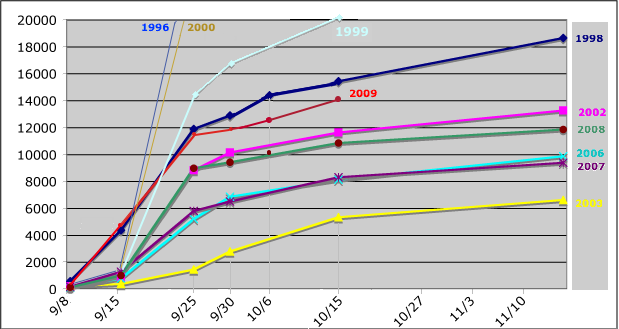|
Annual counts | Distribution (time of day, week) | Changes (last 8 yrs) | Links | Articles | Sources
 The Chimney Rock Hawk Watch accessible via a paved trail from the parking lot at the end of Miller Ln. off of Vosseller Ave. just north of Rt. 22 in Martinsville was started in 1990 by Christopher Aquila. Chris coordinates a group of birders which staff the site from September 1 to November 15. You can learn a lot by just standing around and listening to them call out sightings.
The Chimney Rock Hawk Watch accessible via a paved trail from the parking lot at the end of Miller Ln. off of Vosseller Ave. just north of Rt. 22 in Martinsville was started in 1990 by Christopher Aquila. Chris coordinates a group of birders which staff the site from September 1 to November 15. You can learn a lot by just standing around and listening to them call out sightings.
John Kee compiles the data at chimneyrock.s5.com which is the basis for the analysis below.
There is older historical data at www.rci.rutgers.edu/~magarell/chimney_rock/
Maps: Martinsville, Washington Valley Park
You will usually get 2-5 days between September 12th and 25th, where Large kettles of broad winged hawks form over Chimney Rock, occasionally with more than 1,000 birds.
Hawks form "kettles" (called "boils" in NY) in thermal updrafts during migration. When they find a column of warm, rising air they stretch out their wings to rise with it. Other hawks see the kettle forming and join the crowd. The kettle grows and grows.
As each hawk reaches altitude at the top of the thermal he sets his wings and glides away toward his destination.
Other Links:
Current Counts at Hawk Migration Assiciation of North America's (HMANA) hawkcount.org (NJWMP at Chimney Rock)
Totals Excluding Vultures. (see yearly totals below)
| Totals * thru | 1996 | 1998 | 2000 | 2002 | 2003 | 2006 | 2007 | 2008 | 2009 |
| Sep 08 | 108 | 550 | 289 | 178 | 178 | 119 | 148 | 112 | 248 |
| Sep 15 | 1,574 | 4,354 | 1,542 | 874 | 357 | 754 | 1,269 | 990 | 4,609 |
| Sep 25 | 26,691 | 11,859 | 22,439 | 8,810 | 1,438 | 5,176 | 5,769 | 8,955 | 11,534 |
| Sep 30 | 27,399 | 12,909 | 24,711 | 10,125 | 2,768 | 6,843 | 6,486 | 9,405 | 11,850 |
| Oct 15 | 29,623 | 15,416 | 27,075 | 11,603 | 5,320 | 8,101 | 8,291 | 10,826 | 14,032 |
| Oct 19 | | 16,325 | | 11,214
| 14,110 |
| Nov 15 | 31,470 | 18,632 | 28,368 | 13,241 | 6,585 | 9,835 | 9,366 | 11,824 | |
| Nov 30 § | 31,564 | 18,727 | |
| Highest two days | 1996 | 1998 | 2000 | 2002 | 2003 | 2006 | 2007 | 2008 | 2009 |
| Day | Sep 20 | Sep 24 | Sep 22 | Sep 17 | Sep 30 | Sep 21 | Sep 16 | Sep 18 | Sep 19 |
| Count | 17,923 | 5,353 | 7,450 | 4,128 | 1,151 | 1,619 | 3,703 | 4,484 | 3,674 |
| Day | Sep 19 | Sep 10 | Sep 25 | Sep 24 | Oct 01 | Sep 25 | Sep 15 | Sep 16 | Sep 15 |
| Count | 5,018 | 990 | 6,163 | 1,453 | 562 | 1,301 | 770 | 1,818 | 2,876 |
* less vultures
§ Count stoped on Nov. 15 in recent years
Most of the variability comes from Sept 15-25 which usually accounts for 40-70% of the total; The number of sightings from Sept 25 to Nov 15 on the lowest year, 2003, was 3,800 and on the highest year, 1996, was 4,100.
|
Sources:
- Species Records thru 2005 by John Kee
- A Five Year Analysis of Autumn Hawk Migration at Chimney Rock, Martinsville, N.J. (1990-1994) , by Christopher D. Aquila & Steven B. Byland
- Species Records Page and
Flight Distribution
Pictures in Bird Watching.
Decline

Hawk Mountain and Montclair counts for Sept. only.
Chimney rock Sept. totals account for 69-87% (Av. 76%) of the total.
| Species | Chimney Rock | Cape May * |
| 1996-2000 | 2004-2008 | Decline/
Increase |
| Average # | % of total | Average # | % of total | | % of total | Decline/
Increase |
| Broad-winged | 15,688 | 65.6% | 5,980 | 53.5% | -62% | | 3% | -54% |
| Sharp-shinned | 3,876 | 16.2% | 2,458 | 22.0% | -37% | | 45% | -47% |
| Am. Kestrel | 1,724 | 7.2% | 779 | 7.0% | -55% | | 13% | -48% |
| Osprey | 733 | 3.1% | 468 | 4.2% | -36% | | 6% | -49% |
| Cooper's | 475 | 2.0% | 467 | 4.2% | -2% | | 15% | 32% |
| N. Harrier | 278 | 1.2% | 213 | 1.9% | -23% | | 3% | -40% |
| Merlin | 276 | 1.2% | 197 | 1.8% | -29% | | 5% | -25% |
| Red-shouldered | 242 | 1.0% | 184 | 1.6% | -24% | | 1% | 4% |
| Red-tailed | 271 | 1.1% | 155 | 1.4% | -43% | | 5% | -48% |
| Bald Eagle | 90 | 0.4% | 129 | 1.2% | 44% | | 0.8% | 46% |
| Peregrine Falcon | 77 | 0.3% | 98 | 0.9% | 27% | | 4% | 0% |
| Golden Eagle | 11 | 0.05% | 14 | 0.13% | 31% | | 0.05% | -19% |
| N. Goshawk | 7.0 | 0.03% | 2.4 | 0.02% | -66% | | 0.1% | -48% |
| Rough-legged | 1.2 | 0.01% | 0.6 | 0.01% | -50% | | 0.002% | -82% |
| Unidentified |
| Raptor | 86 | 0.4% | 16 | 0.1% | -82% | | | |
| Acciptor | 42 | 0.2% | 11 | 0.1% | -75% | | | |
| Buteo | 19 | 0.1% | 5 | 0.0% | -72% | | | |
| Falcon | 12 | 0.1% | 5 | 0.0% | -58% | | | |
| Total | 23,909 | | 11,182 | | -53% | | 33,511 | -39% |
* Cape May % of total: 2004-2008; Decline: 1996-2000 vs 2004-2008. See Cape May page
Sources: chimneyrock.s5.com by John Kee
Hawk Migration Assiciation of North America's (HMANA) hawkcount.org
Decline:
There are a variety of factors which more experienced birders have proposed to account for the decline. I couldn't find any definitive studies.
- Weather patterns - From 1995 to 2000 Chimney Rock counts were down in years when Hawk Mountain counts were up. Could weather be pushing the birds further west?
- More backyard feeders and loss of neotropical prey has been proposed as reason for sharp-shin migratory short-stopping (Wintering at more northerly latitudes). See articles below.
- Reduction of habitat in the north.
- Regional drought in the late 1990s resulted in reduced stream flows and water levels, which in turn affected fish populations in the southwest.
- The declines vary by species and location.
- Most species have recovered from their decline due to DDT (1946-1972), loss of habitat and hunting.
- Bird flu.
- Climate change has been suggested as a factor, but that is probably based on Feb. 2009 Audubon Society study showing many birds wintering an average of 35 miles farther north because of a 5° F rise in the average January temperature in the US over the last 40 years. This does not account for birds wintering more than 1,000 miles farther north where where the winter low averages 40° F cooler (0° in southern NY vs 40° in northern Mexico).
See:
"Using Autumn Hawk Watch to Track Raptor Migration and to Monitor Populations of North American Birds of Prey" - Article on Sharp Shinned migration decline - USDA Forest Service Gen. Tech. Rep. PSW-GTR-191. 2005
Demography and Populations -- Sharp-shinned Hawk -- Birds of North America Online at Cornell says:. (Requires subscription: $5/mo, $42/yr)
"Sharp-shinned hawks are the most difficult accipiter and among the most difficult birds to census in North America."
"Declines in counts at migration watchsites in e. North America from 1940s to early 1970s almost certainly due to widespread use of DDT."
"Declines in the 1980s and early 1990s initially were attributed to various factors acting singly or in concert: environmental contaminants (mainly organochlorines), migratory short-stopping, natural population cycles, depressed populations of Neotropical migratory prey species, and the aging of eastern forests. Recent analyses of concurrent Christmas Bird Count data from the region, however, have revealed significant increases in numbers of Sharp-shinned Hawks overwintering in areas north of the watchsites in question (i.e., e. Canada and the ne. U.S.), strongly suggesting that the declines are due to migratory short-stopping—perhaps the result of increased use of bird feeders as hunting habitat by sharp-shins—and not to an overall decline in eastern populations (Dunn and Tessaglia 1994, Duncan 1996, Viverette et al. 1996)."
Viverette, C. B., S. Struve, L. J. Goodrich, and K. L. Bildstein. 1996. Decreases in migrating Sharp-shinned Hawks at traditional raptor-migration watchsites in eastern North America. The Auk 113:32-40.
Conservation Status Report - Sharp-shinned Hawk, 2007 at HawkMountain.org states:
"From 1974 to 2004, migration counts declined a statistically
significant 1.1 % per year at Hawk Mountain Sanctuary, Pennsylvania and 4.5
% per year at Cape May Bird Observatory, New Jersey."
"The decline in
numbers at Cape May might indicate declined reproductive success, as most individuals
counted at Cape May Point are juveniles."
"The discrepancy between migration
trends (lower) and those from CBCs (Christmas Bird Counts) (higher) may be due to migratory short-stopping."
Fall Raptor Migration over Lake Erie Metro Park (increasing)
State of the Birds - The 2009 Report from the Interior Dept. shows that Wetland birds are increasing while Grasland and Aridland birds are declining.
Saving Migratory Birds for Future Generations: The Success of the Neotropical Migratory Bird Conservation Act, Compiled by American Bird Conservancy, May 2009
A Feb. 2009 Audubon Society study found that more than half of 305 birds species in North America, a hodgepodge that includes robins, gulls, chickadees and owls, are spending the winter about 35 miles farther north than they did 40 years ago.
Over the 40 years covered by the study, the average January temperature in the United States climbed by about 5 degrees Fahrenheit, which they speculate may be the reason. (Hawks were not mentioned in the summary I saw.)
Potential Impacts of Global Climate Change on Bird Communities of the Southwest
by Charles van Riper III, Mark K. Sogge, and David W. Willey
Biological Resources Division
U.S. Geological Survey
Species mix Chimney Rock vs Cape May:
Buteos (Broad Winged hawks in particular) like to exploit updrafts off of ridges, hence the large numbers at Chimney Rock on the first range of the Watchung Mountains.
Falcons (Peregrine, Kestrel, Merlin) rely more on their own powers of flight and do not need mountain updrafts.
Accipiters (Sharp-shinned, Coopers Hawks, ...) and falsons tend to follow the shorelines, hence higher counts at Cape May.
Other Hawk Watch Sites:
Counts are for Fall only.
See map at: www.rci.rutgers.edu/~magarell/chimney_rock/about_cr.html
| Site | Location | Median
Fall
Totals | 2002
Total |
| Cape May | Cape May, NJ | 50,000 | 35,267 |
| Hawk Mountain | Kempton, PA | 20,000 | 21,708 |
| Chimney Rock | Martinsville, NJ | 19,000 | 13,241 |
| Monclair | Monclair, NJ | 12,000 | 11,340 |
| Militia Hill | Fort Washington State Park, PA | 9,000 | |
| Wildcat Ridge | Hibernia, NJ | 9,000 | 7,011 |
| Racoon Ridge | Blairstown (Hemlock Glen), NJ | 15,000 | * 4,238 |
| Scotts Mountain, Merrill Creek | Washington, NJ | 9,000 | 8,737 |
| Sunrise Mountain | Stokes State Forest, Branchville, NJ | | * 4,678 |
| Bake Oven Knob | Germansville, PA | | 20,778 |
(Median 1998-2002)
* Racoon Ridge only counted for 9 days in Sept. 2002
* Sunrise Mountain only had counts for 13 days in Sept. 2002
Some sites keep Spring totals also (Feb-May) which are about 1/3 of Fall totals.
Other New Jersey sites at: New Jersey Sites, Hawk Migration Assiciation of North America (HMANA)
and the JerseyBirds mail list.
Scherman-Hoffman Wildlife Sanctuary (New Jersey Audubon Society)
Bernardsville, (908) 766-5787
Migration:
 Typical Broad winged hawks migration:
Typical Broad winged hawks migration:
Sept. 10 - Lake Ontario
Sept. 15 - Mass.
Sept. 17 - NJ and PA
Oct. -1 - Texas
Red-Tails and others tend to be later.
Hawks will fly around 10 hours per day and travel from 100 to 250 miles.
Ducks and geese might travel as much as 400 to 500 miles per day.
Wintering locations:
| Broad-wings | Central America and N. South America |
| Sharp-shinned | Southern US, Central America |
| Coopers | Gulf coast, Mexico to Honduras |
| Kestrel | Coastal Mexico, Central America |
See:
Flyways And Byways at 10000birds.com
New Jersey Osprey Project
Terms:
BBS - Breeding Bird Survey
CBC - Christmas Bird Count
Articles
- John Kee - Species Records thru 2005
- Christopher D. Aquila & Steven B. Byland - A Five Year Analysis of Autumn Hawk Migration at Chimney Rock, Martinsville, N.J. (1990-1994)
- Kyle McCarty and Keith L. Bildstein - "Using Autumn Hawk Watch to Track Raptor Migration and to Monitor Populations of North American Birds of Prey", USDA Forest Service Gen. Tech. Rep. PSW-GTR-191. 2005
- Robyn Worcester, Ron Ydenberg - Cross-Continental Patterns In The Timing Of Southward
Peregrine Falcon Migration In North America, 2008,
- Johnd Elong, Stephen W. Hoffman - Differential Autumn Migration Of Sharp-Shinned And
Cooper's Hawks In Western North America
Links
Bird Watching Here
Cornell Lab of Ornithology
Cornell's All About Birds
The Hawk Conservancy Trust
Chimney Rock Hawk Watch: Other Birding Sites
Data entry overload? Learn eBird tricks and tips! - eBird.org
Binoculars,
Birding and Raptors in Northwest New Jersey at www.njskylands.com
Links at main Hawk Watch Page
Bird Watching in hobbies
Squirl Proof Bird feeders
Autumn Raptor Migration
NPWRC :: Migration of Birds
Sources:
chimneyrock.s5.com John Kee.
www.rci.rutgers.edu/~magarell/chimney_rock/
Return to: Martinsville Information
last updated 19 Oct 2009 |


 Typical Broad winged hawks migration:
Typical Broad winged hawks migration: